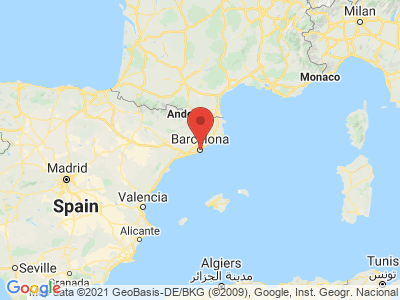Climate Table Barcelona
Jan | Feb | Mar | Apr | May | Jun | Jul | Aug | Sep | Oct | Nov | Dec | |
|---|---|---|---|---|---|---|---|---|---|---|---|---|
| Max. Temperature | 13° | 14° | 16° | 18° | 21° | 25° | 28° | 28° | 25° | 21° | 16° | 13° |
| Min. Temperature | 6° | 7° | 9° | 11° | 14° | 18° | 21° | 21° | 19° | 15° | 11° | 8° |
| Sun Hours | 5 | 6 | 6 | 7 | 8 | 9 | 10 | 9 | 7 | 5 | 5 | 4 |
| Water Temperature | 13° | 12° | 13° | 14° | 16° | 19° | 22° | 24° | 22° | 20° | 16° | 14° |
| Rain Days | 4 | 4 | 5 | 6 | 6 | 4 | 2 | 5 | 4 | 6 | 6 | 5 |
The climate year of Barcelona
Barcelona is the capital of the Catalonia region and also the second largest metropolis in Spain. A total of about 1.6 million people live in the city area, and the wider catchment area of the metropolitan region even has more than 4.8 million inhabitants. This makes Barcelona the eleventh largest municipality within the European Union (EU) and - after Hamburg - the second largest that is not the capital of the EU member state in question. About 120 kilometers south of the French border and the Pyrenees the Catalan capital enjoys a privileged location on the Mediterranean Sea. The plateau, about five kilometers wide, on which the city is located, is bordered by the rivers Besòs and Llobregat and the mountain range of the Serra de Collserola. To the southeast, the urban area borders directly on the Mediterranean Sea. The mountain Montjuïc, in the southwest of the city, offers a good view of the port and was probably chosen for this reason as the location for the fortress located here.
General information about Barcelona
For tourists, Barcelona is one of the most popular destinations in Spain. Architecture enthusiasts will find a fascinating juxtaposition of significant monuments here, ranging from ruins of Roman antiquity to medieval buildings and the modern planned city of Eixample. The most famous street in the city is La Rambla. On the wide avenue, which serves mainly as a promenade and extends from the center to the port, you can find numerous bird and flower sellers, kiosks and gastronomic offers. Plaça Reial, characterized by arcades and palm trees, and the internationally renowned opera house Gran Teatre del Liceu are also among Barcelona's tourist highlights. And of course, a visit to Barcelona would not be complete without a detour to the still unfinished basilica "Sagrada Família" and the numerous other buildings by Antoni Gaudí or to the city's art museums.
Tourism Barcelona
The Mediterranean climate of Barcelona in the summer months is mainly determined by the Azores high. July and August are usually the hottest months, with the average temperature in summer being around 28 degrees Celsius. In the winter months, on the other hand, a somewhat cooler and more humid climate prevails, as is the case throughout the western Mediterranean. The average temperature in winter is 13 degrees Celsius. The fact that Barcelona is shielded by the surrounding mountain ranges from the cold winds that often blow across Catalonia from the Pyrenees also contributes to the mild winters. The spring months of March and April are particularly suitable for a city trip to Barcelona, when the large influx of tourists has not yet resumed and daytime temperatures of 20 degrees can be reached despite the mostly still cool nights. Early summer in the months of April and June usually offers a pleasantly warm climate without extreme heat. In September and October the evenings become a bit cooler, but often the water is still relatively warm and invites you to swim. Late autumn and winter are suitable for those who want to go out in the evening in Barcelona without suffering from heat. Then it can also rain more often, but usually only in short showers and not as continuous rain.


